(Click here to see a full-size version of the modified photo on the lower right)
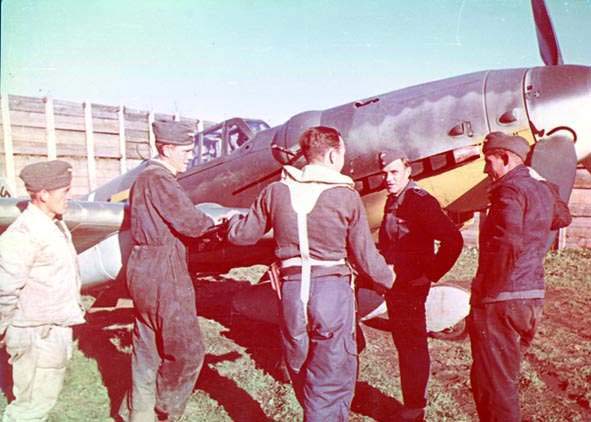
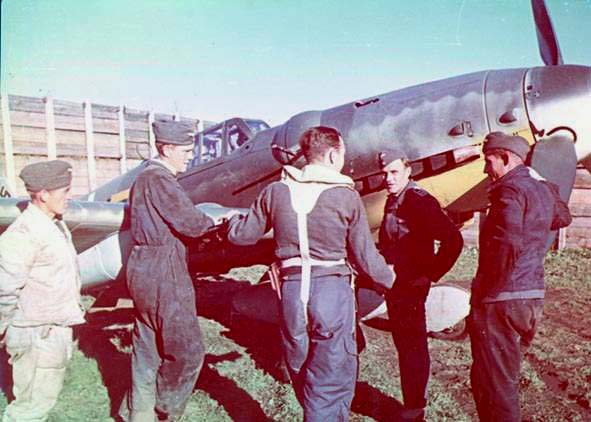
|
European Operations |
| The first photo
comes to us from Marko Jeras; to illustrate the points noted on the front page, I've posted the
(mostly) unmodified print on the left which shows a bit of a red shift in the
color tone, and the subsequent result after some color balance, brightness, and
contrast adjustment in Photoshop. This is a G-6/R6 (note the gondola and
the crew leaning on the 20mm barrel), no word on unit or ID.
(Click here to see a full-size version of the modified photo on the lower right) |

|
| The earliest Bf109s were not left in their original 70/71/65 camouflage; as they transitioned to the Jagdfliegerschule, they were repainted in accordance with standard RLM documentation, as evidenced by this Bf109C or D in a picturesque winter setting. |
|
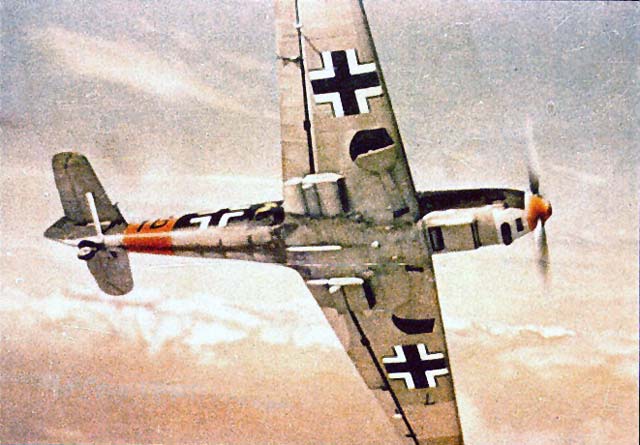 |
At left, an
Emil of a training unit (JFS) cavorts in the clouds...
The colored fuselage band carrying the aircraft number is certainly worthy of note, and there appears to another indistinguishable marking just forward of the fuselage Balkankreuz . The black smudge just aft of the foremost chin intake may be a flaw on the picture, as it doesn't correspond with any duct on an Emil. The streaking along the aft fuselage from the vicinity of the fuel tank is certainly an interesting feature, although it would seem to be an alarming one at that! |
|
|
Taken from an official Messerschmitt calendar (as I recall), this unusually-marked Gruppenkommandeur's Emil has yet to be identified. The tightly mottled uppersurface scheme is worthy of note, in addition to the aforementioned "triple chevron" marking. The possibility exists that this is actually a carefully retouched photo, the triple chevron being added at a later date... |
| Presumably taken just as the F-2 variant was entering service with JG2 and JG26 on the Kanalfront, this may be an aircraft just assigned to one of the aforementioned units, in that there is no Staffelkennzeichen but the rudder is already painted yellow. |
| Another submission from Marko Jeras, this time a JG77 G-6 getting the oil checked...this is a "bone-stock" Bf109G-6, 74/75/76 with 04 lower cowl, spinner 1/3 white...nothing terribly extraordinary here except that this is a beautiful color picture! | 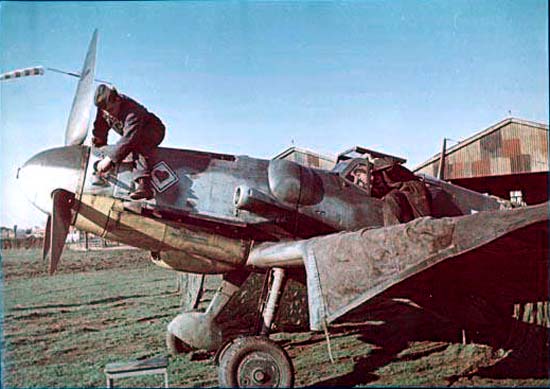 |
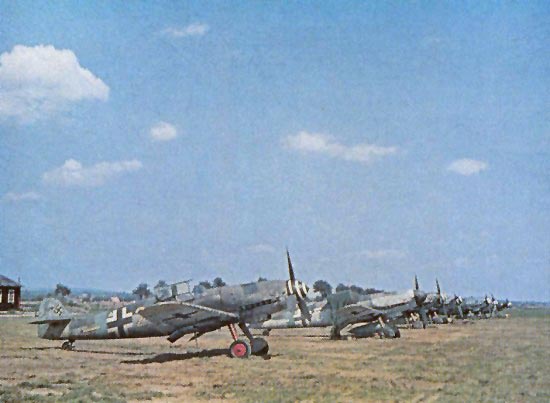 |
This is one
of the more famous color 109 photos; this shows a lineup of G-6/AS
aircraft of II./JG27 at Fels am Wagram in August 1944. According to
the Prien/Rodeike 109F-G-K book, the nearest aircraft is W.Nr. 412807
"gelbe 2", shot down near St. Pölten on 23 August 1944 with the
pilot Uffz. Zimmerman being killed. "Weiße 5" behind it
may be W.Nr. 412918, shot down near Holzminden on 16 August with the
wounded pilot Uffz. Salinger escaping by parachute.
Worthy of note are the yellow underwing tips, the RLM25 Grün RVT bands immediately aft of the Balkankreuz, and the Spiralschnauze on "gelbe 2" but not on "weiße 5". Also, all aircraft carry a relatively standard 74/75/76 scheme. All visible aircraft carry the R3 droptank mod, and "gelbe 2" has the fuselage-mounted FuG 16zy Morane mast (look carefully...it appears to be striped, but that may be an illusion). This leads us neatly into the next picture... |
| Whoops...
No word on what caused this, but my personal guess is bomb damage- note the prop blades are unbent, so the engine was not turning when this calamity occurred, and it didn't hit nose first because the spinner, though well-dented, is not flattened. Plus, there was no fire (strange in any event, given that the belly tank is still present!) So, here's the exciting part...note the wheelwells, 76 throughout (even the aft wall liner). Note also that 76 is used in the flap well (see the inside of the port upper "gator" flap). That's not all, of course. The shades of 76 and 04 are notably lighter than that commonly used in scale modeling; these also dovetail nicely with some fabric samples I have from a JG5 Fw190 aileron showing traces of the brush-painted yellow wingtip markings as well as the pale, almost white variety of 76. The yellow here appears to be brush-painted as well; note the demarcation line. And of course, we note the red legs and wheels, indicating this is (or was...) likely a G-6/AS aircraft. The spine shows an octane triangle for the aft primer tank, and the RLM25 Grün band shows up well here. And take a look at the drop tank style...not the common "ribbed" 300 liter tank, but the later two-piece stamped variety. All in all, an utterly fascinating photograph! |
 |
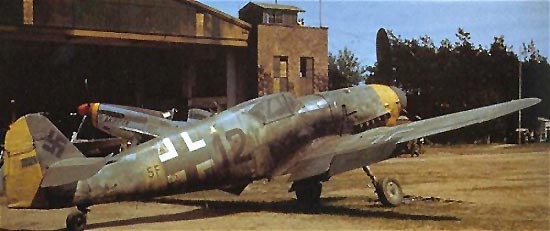 |
Fürth,
Germany, May 1945..."for you, the war is over!"
This well-known photo of a NAG G-10/R2 shows just how hard the Luftwaffe was pressed in the last days of the war. No attempt at cleaning the aircraft has been made, not even a cursory wiping off of the characteristic sooty exhaust from the DB605. Here we see the deeper shade of 04 Gelb which we're all familiar with. The uppersurface colors appear to be 81/83 with patches of 75 (?) on the fuselage; the undersurface may have been 76 at one time, but it's so filthy that this is only a guess! Closer examination of this shot as printed in "Fighter Command" shows that the "5F" is actually on a poorly overpainted yellow fuselage band immediately aft of the cross. Note also the absence of gear covers. Goes to show you that yes, they DID get this dirty... |
| This one was actually a complete surprise... there is a color video (from which the pictures of -o+- were taken in the Ostfront page) that features some inflight color footage of 109s flitting about. I happened to stop the video at *just* the right time completely by accident, and was quite pleased to find this... it's an Emil coded "schwarze 5 + -" of the 5th staffel of an unknown Geschwader (possibly JG2 or 3?) . | 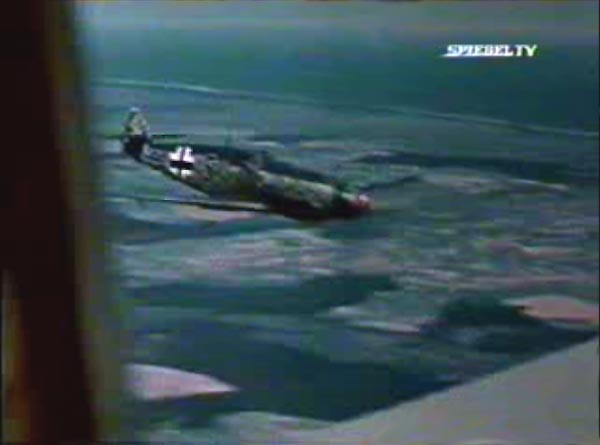 |
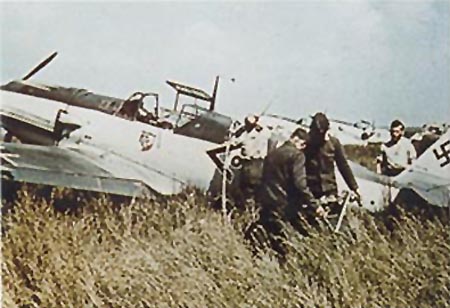 |
Another of Pichon-Kalau vom Hofe's aircraft, this time an E-4 flown while he was with I./JG20 during the Battle of Britain. A number of decal sheets feature this aircraft, but none so far call out the painted cowl gun troughs; this was presumably a decorative feature, and was quite common on prewar and early-war Emils in the overall 70/71/65 scheme. This machine still carries the earlier uppersurface colors but features the updated marking schema. |
| Another Signal photo, this 109 features a quite flamboyant appellation on the fuselage side; note the stenciling is in red on this aircraft (see the "1" marking the first fuselage station at the very right of the photo), and that the 65 bears a close resemblance to that on "schwarze 11" shown above. | 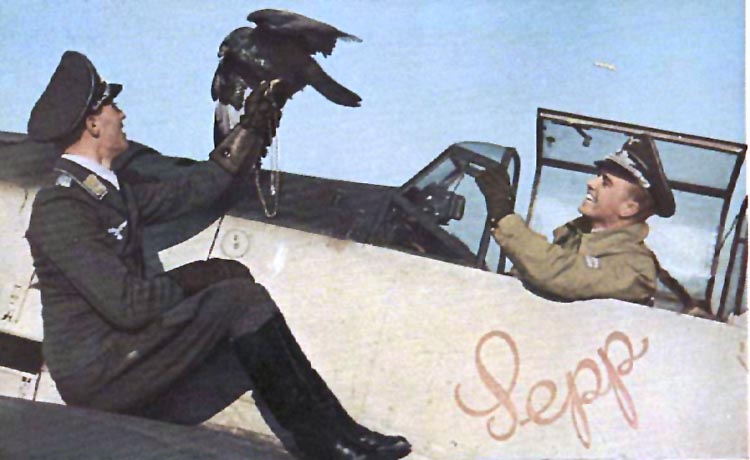 |